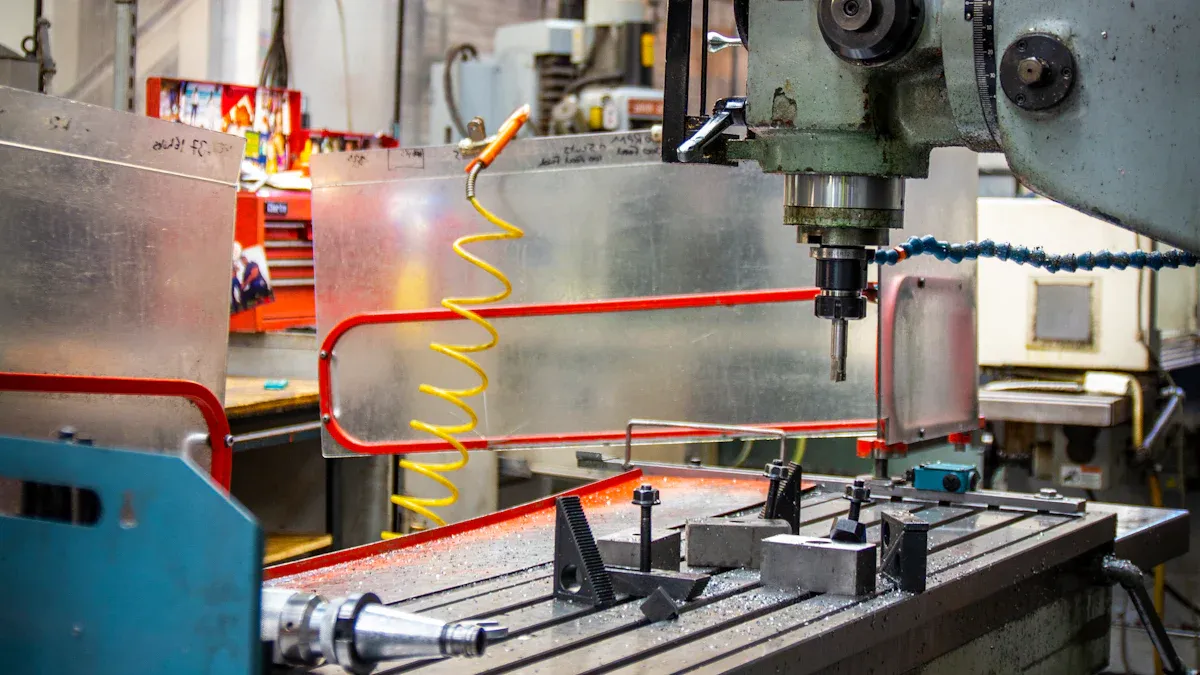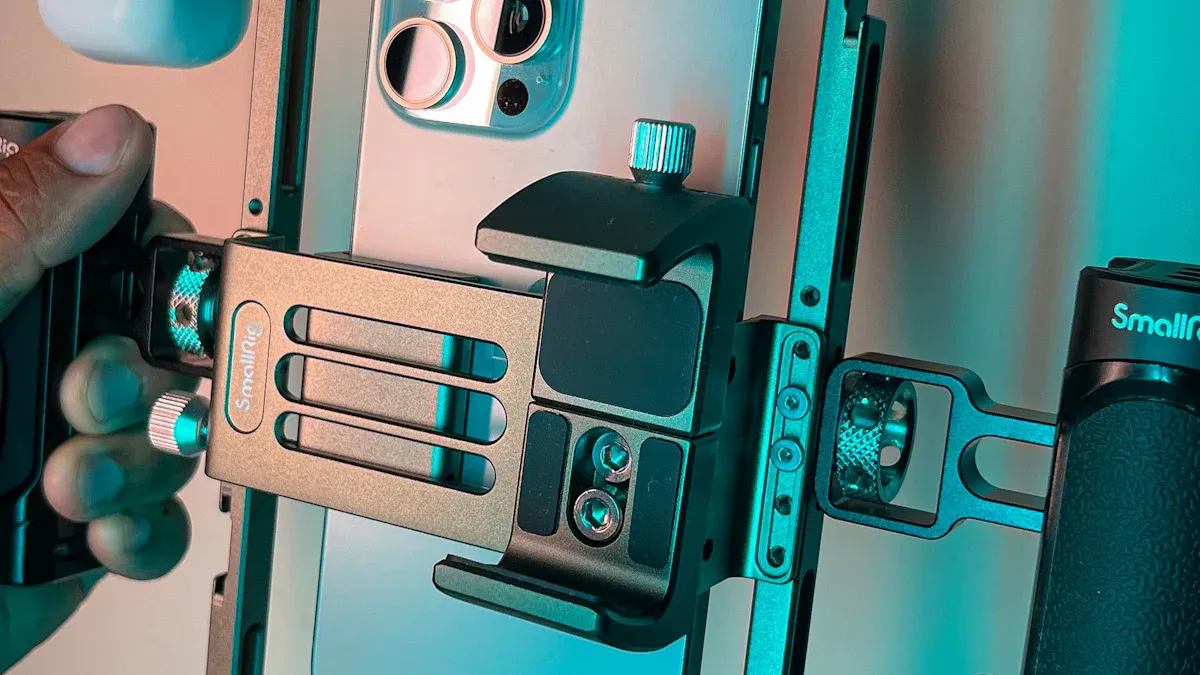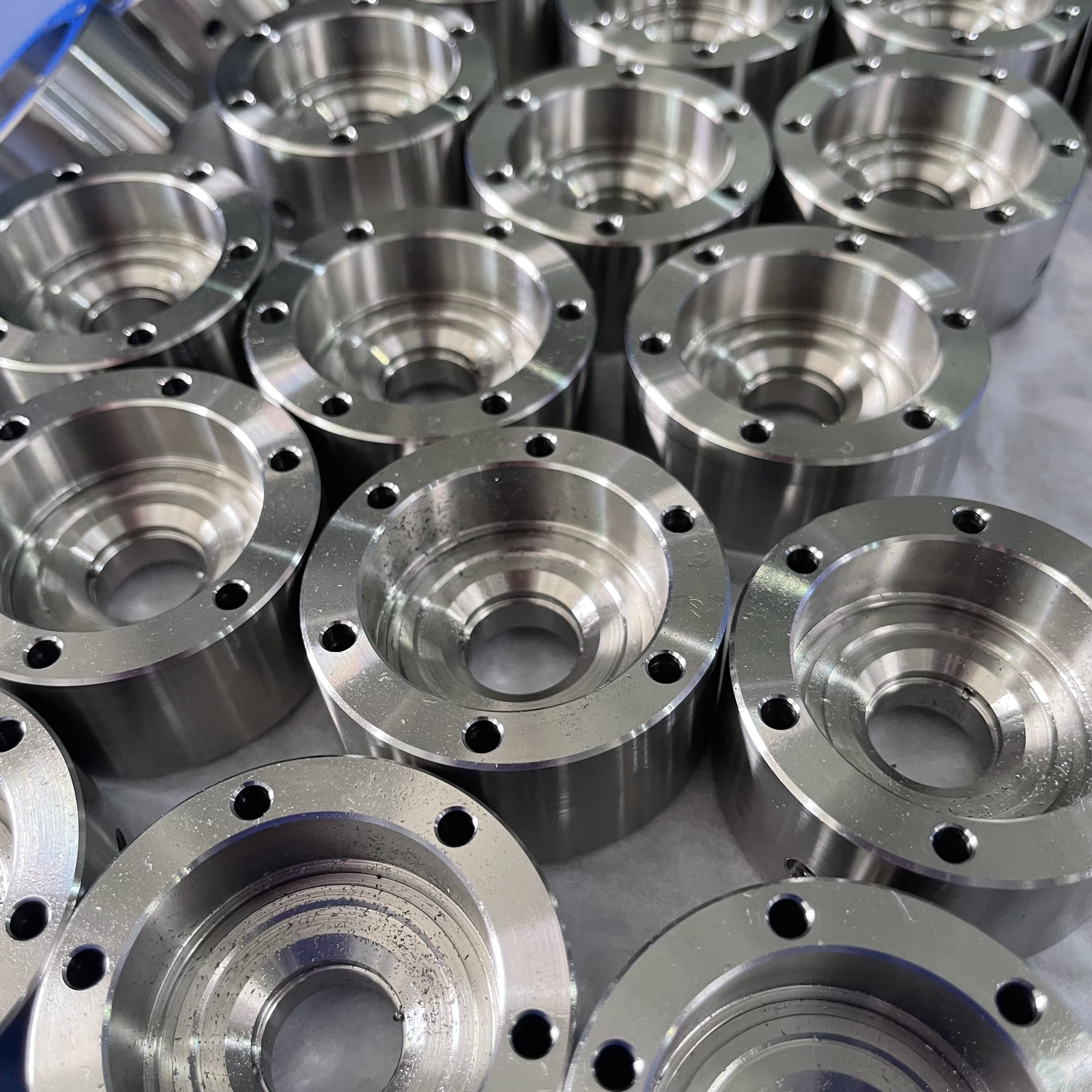How CNC Precision Parts Are Used in the Aerospace Industry

You rely on CNC precision parts to meet the aerospace industry's demand for high-performance components. Over the past decade, CNC machining has revolutionized production by enabling intricate geometries and lightweight designs. This technology ensures high accuracy, often within microns, while working with materials like titanium and aluminum alloys to meet strict safety standards.
Key Takeaways
CNC machines make aerospace parts accurate and dependable, meeting safety rules.
Lightweight metals like aluminum and titanium help planes use less fuel and work better.
CNC tools speed up new ideas by quickly testing and changing designs.
The Importance of CNC Precision Parts in the Aerospace Industry
What Makes CNC Machining Essential for Aerospace?
You rely on CNC machining to meet the aerospace industry's demand for precision and reliability. This technology ensures that components meet strict safety standards while maintaining high performance. CNC machines excel at creating intricate geometries by controlling multiple axes simultaneously. This capability is vital for manufacturing complex aerospace parts, such as turbine blades and fuselage frames. The process also achieves tolerances within microns, ensuring consistent quality across all components.
CNC machining plays a critical role in aerospace manufacturing. Automated processes like milling, turning, and drilling allow you to produce parts with exceptional accuracy. Engineers can also use advanced simulation tools, such as Finite Element Analysis (FEA), to test designs before production. This ensures that every component performs as expected under real-world conditions.
The Role of High Precision Parts in Aerospace Applications
High precision parts are essential for the safety and performance of aerospace vehicles. You depend on these components for critical systems, including propulsion, landing gear, and avionics. Even minor deviations in dimensions can lead to catastrophic failures, making precision non-negotiable. For example, engine components like turbine blades and compressor disks require exact tolerances to function efficiently under extreme conditions.
These parts also contribute to the structural integrity of aircraft and spacecraft. Fuselage frames, wing ribs, and bulkheads must withstand significant stress while remaining lightweight. By using CNC machining, you can ensure that these components meet the industry's rigorous standards for safety and reliability.
Materials Used in Aerospace CNC Machining
The aerospace industry uses a variety of materials to balance strength, weight, and durability. Aluminum and its alloys are popular choices due to their lightweight properties and corrosion resistance. Titanium alloys offer superior strength-to-weight ratios, making them ideal for airframes and jet engine components. Inconel superalloys, known for their heat resistance, are often used in high-demand applications like turbine blades.
Other materials, such as carbon steel and high-performance plastics, also play a role. Carbon steel provides the tensile strength needed for structural components like landing gear. High-performance plastics are lightweight and corrosion-resistant, making them suitable for cabin and interior parts. By selecting the right material, you can optimize performance while reducing overall weight.
Applications of CNC Precision Parts in Aerospace

Aviation: Manufacturing Aircraft Components
You depend on CNC machining to produce critical components for commercial airplanes and other aircraft. This technology allows you to create intricate parts with exceptional precision, ensuring safety and performance. CNC precision parts play a vital role in manufacturing:
Aerospace manufacturing tools
Outer shells, wings, and fuselage frames
Engine components, including turbine blades and casings
Landing gear systems and structural elements
Avionics housings and lightweight interior components
CNC machining enhances the efficiency and reliability of aircraft by ensuring dimensional accuracy and tight tolerances. These qualities are essential for maintaining proper functionality and safety. By minimizing waste and streamlining production, CNC machining also reduces costs while delivering high-quality results.
Space Exploration: CNC Machined Spacecraft Parts
In space exploration, you rely on CNC machined parts to meet the extreme demands of the environment. These components must withstand temperature fluctuations, radiation, and high pressures. CNC machining ensures the precision needed for spacecraft parts like:
Engine components and life support systems
Wings and fuselage elements
Landing gear and airframe structures
The machining process guarantees thermal stability and radiation resistance, which are critical for long-term missions. By using CNC precision parts, you can ensure the safety and performance of spacecraft during assembly and operation.
Lightweight and Durable Materials for Aerospace
Lightweight materials are essential for improving the performance and fuel efficiency of aerospace vehicles. CNC machining enables you to work with materials like aluminum and titanium, which offer high strength-to-weight ratios. For example:
Titanium is as strong as steel but 45% lighter.
Aluminum is 33% lighter than steel, contributing to better fuel economy.
These materials also provide heat resistance and corrosion resistance, making them ideal for aerospace applications. By reducing the weight of aircraft, you achieve better acceleration, structural strength, and fuel efficiency. The Boeing 787, for instance, improved fuel efficiency by 10–12% with a 20% weight reduction.
Benefits of CNC Machining in Aerospace
Precision and Consistency in High-Performance Parts
You rely on CNC machining to achieve unmatched precision and consistency in aerospace manufacturing. This technology ensures that every component meets tight tolerances, often as precise as 0.00127 mm—thinner than a strand of human hair. By using pre-programmed commands, CNC machines produce intricate geometries essential for aerospace applications, such as jet engine components. These machines also maintain isotropic properties by crafting parts from a single block of material, ensuring structural integrity and reliability.
Advanced simulation tools, like CAD software, allow you to create exact 3D replicas of components. This ensures strict adherence to specifications and enables performance testing under simulated conditions. With CNC machining, you can consistently produce high-quality parts that perform reliably under extreme conditions, such as high temperatures and pressures in jet engines.
Rapid Prototyping for Aerospace Innovation
CNC machining accelerates innovation in aerospace by enabling rapid prototyping. You can quickly create dimensionally accurate prototypes with precise tolerances, allowing for efficient testing and modifications. This process eliminates the need for traditional molds, reducing costs and enabling design changes without significant financial impact.
Rapid prototyping also enhances safety by providing physical models for testing. You can identify design flaws early, avoiding costly errors during mass production. Additionally, CNC machining supports material versatility, letting you experiment with various materials to find the best fit for aerospace applications. By speeding up the design cycle, you can bring new technologies to market faster, driving advancements in aerospace engineering.
Cost-Effective Production for Complex Components
CNC machining offers a cost-effective solution for producing complex aerospace components. It minimizes material waste by using only the necessary amount, reducing production costs. Traditional methods often generate scrap materials, but CNC machining optimizes manufacturing processes to ensure efficiency.
This technology also shortens production cycles, allowing you to produce high-precision parts faster than traditional methods. The reduced lead times and labor costs make CNC machining an economical choice for aerospace manufacturing. By maintaining quality and reliability throughout the process, you can achieve cost savings without compromising on performance or safety.
Real-World Examples of CNC Machining in Aerospace

CNC Machined Jet Engine Components
You rely on CNC machining to produce critical jet engine components that ensure performance and reliability. These parts are crafted with exceptional precision to withstand extreme conditions during operation. CNC machining allows you to create components from a single block of material, ensuring uniform properties and structural integrity. This process enhances the strength and durability of parts, reducing the risk of mechanical failures.
Key examples of CNC machined jet engine components include:
Turbine blades
Engine mounts
Engine pylons
Component Type | Description |
|---|---|
Aerospace Components | CNC precision parts for the aerospace industry include jet engine parts, turbine blades, panels, seat belt mechanisms, door locks, landing gear, airframe parts. |
These components play a vital role in improving the efficiency and safety of aircraft. The precise construction of turbine blades, for instance, ensures optimal airflow and fuel efficiency, which are essential for high-performance engines.
CNC Parts in Spacecraft Design and Assembly
CNC machining is indispensable for spacecraft manufacturing. You depend on this technology to produce components that can endure the harsh conditions of space. These parts are designed for thermal stability, radiation resistance, and ultra-fine tolerances, ensuring the functionality and safety of spacecraft systems.
Examples of CNC machined components used in space travel include:
Engine components made from Titanium-Aluminide for high strength-to-weight ratios.
Surface finishes that enhance durability and performance in extreme environments.
The precision of CNC machining ensures that every part fits perfectly, reducing the risk of failure during missions. This makes CNC use in space travel a cornerstone of modern aerospace engineering.
Innovations in Aerospace Enabled by CNC Technology
Recent advancements in CNC technology have revolutionized aerospace manufacturing. High-speed machining and multi-axis capabilities allow you to produce complex parts with unparalleled precision. The integration of CNC machining with automation and IoT devices enables real-time data collection and process optimization, further enhancing efficiency.
CNC machining also supports the use of advanced materials like carbon composites and superalloys. These materials help you design lightweight, high-strength components that improve fuel efficiency and sustainability. For example, combining additive manufacturing with CNC processes reduces lead times and costs, accelerating innovation in aerospace engineering.
By leveraging these innovations, you can create cutting-edge designs that push the boundaries of aerospace technology.
CNC precision parts are essential for the aerospace industry, ensuring safety, performance, and compliance with strict standards. You benefit from their ability to achieve tight tolerances, produce lightweight designs, and reduce costs.
Key Advantages:
Enhanced safety through precise machining.
Improved performance under extreme conditions.
Faster production cycles and reduced waste.
By adopting CNC machining, you can meet evolving aerospace demands, optimize production, and stay competitive in a rapidly advancing industry.
FAQ
What are the main advantages of CNC machining in aerospace?
CNC machining ensures precision, reduces material waste, and speeds up production. You can achieve tight tolerances and create lightweight, high-performance components efficiently.
Which materials are commonly used in aerospace CNC machining?
You often work with aluminum, titanium, and Inconel. These materials offer strength, heat resistance, and lightweight properties essential for aerospace applications.
Tip: Always choose materials based on the specific requirements of your aerospace project, such as weight, durability, and environmental resistance.
How does CNC machining improve safety in aerospace?
CNC machining produces parts with exact tolerances, ensuring reliability under extreme conditions. This precision minimizes risks and enhances the safety of aircraft and spacecraft systems.
See Also
Exploring CNC Machining Accuracy in the Aerospace Sector
Achieving Excellence in CNC Machining for Precision Components
Grasping the Order of Precision Parts in CNC Machining
Fulfilling CNC Machining Standards for Precision Component Production
About US
Follow Us
Your prototype holds unparalleled significance, and we deeply value its uniqueness. Collaborating with you during the preparation phase for running your prototype or parts is a commitment we gladly embrace. Whether it's a single part or a complex assembly, we are dedicated to selecting the optimal tools and pathways to bring your envisioned product to life.
At Precision Fab CNC Machining, we specialize in producing parts for prototypes, short runs, and high-volume production. Our prototyping machine capabilities extend across metal, plastic, and wood machining, with welding fabrication services available to complement and finalize your prototype if required.
Address
Address: Room320 10F, Building A,Nanshan international building, Dayawan District, Huizhou, Guangdong, 516001 China
Contacts
billy@timaycnc.com

